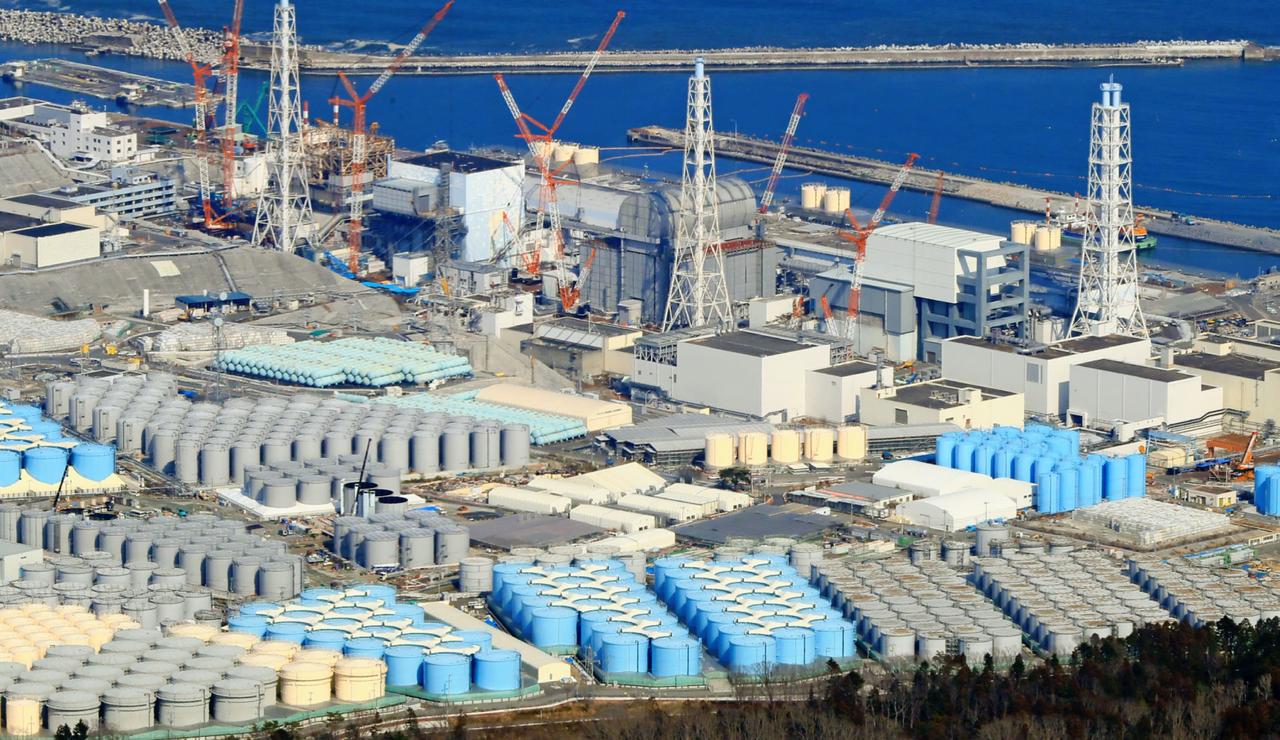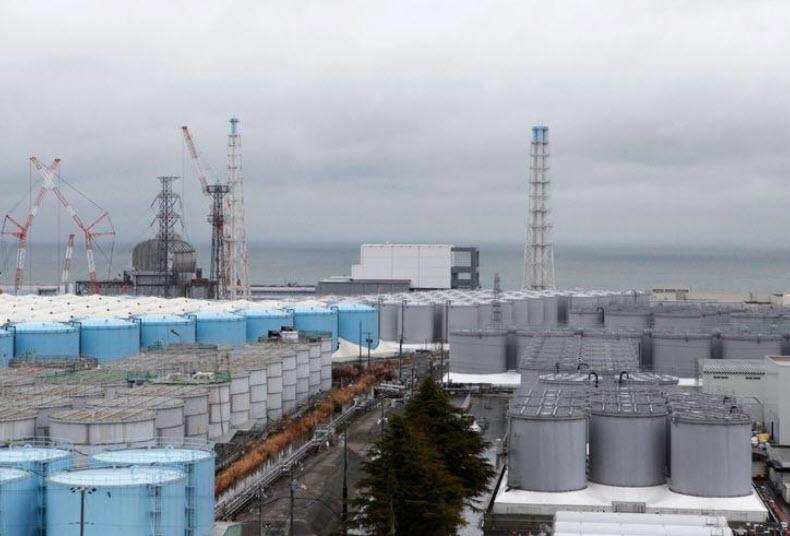Ongelofelijk
maar alweer waar: Tepco, de Japanse eigenaar van de Fukushima kerncentrale, wil toestemming van de Japanse overheid om 1,2 miljoen ton radioactief besmet water in zee te lozen (ter verduidelijking: een ton is
duizend liter en dat 1,2 miljoen maal…..)….. De centrale kampt met capaciteitsproblemen, er staan
intussen duizend grote tanks op het terrein, die bijna
allemaal zijn gevuld met radioactief besmet water…….
Eén en
ander geeft nog eens aan dat minstens 1 van de beschadigde reactoren
nog steeds niet onder controle is, immers de tanks moeten leeg voor de volgende miljoenen liters radioactief besmet water…… Dan te bedenken dat de
Japanse regering bezig is om mensen die bij het begin van deze enorme
kernramp werden geëvacueerd, te herhuisvesten in het radioactief
besmette gebied en zelfs in de buurt van de kerncentrale…….
Vergeet
niet dat al een jaar of 7 geleden voor het eerst vissen met afwijkingen door radioactieve straling van deze kerncentrale,
zelfs voor de kust van Californië werden gevangen……. De
hoeveelheid radioactief besmet water die Tepco wil lozen is zo groot dat een ramp niet
uitgesloten moet worden aldus deskundigen (trouwens daar behoef je niet deskundig voor te zijn), waar in de toekomst opnieuw lozingen van honderden miljoenen liters radioactiefbesmet water ‘nodig zijn…..’ (dat is niet nodig, gewoon op blijven slaan en daarbij proberen op een veilige manier het water te zuiveren, bijvoorbeeld door gecontroleerde verdamping, immers de schade die e.e.a. zal aanrichten in het zeeleven, is niet met een pen te beschrijven!!)
Lees het
volgende artikel van ‘Tyler Durden, eerder gepubliceerd op Zero Hedge
en zegt het voort, zeker nu ook hier weer stemmen opgaan om de meer dan
verdoemde technologie van kernenergie in te zetten tegen de klimaatverandering……. Terwijl alleen de bouw van zo’n centrale al een enorme belasting is voor het milieu en daarmee voor het klimaat, dit nog buiten de uiterst vervuilende delving van uranium…. Voorts is kernenergie niet in een bedrag voor de kilowattuurprijs uit te drukken, zo gaan er kapitalen aan belastinggeld verloren aan subsidies voor deze enrgieopwekking en is er geen verzekeringsmaatschappij die een centrale wil verzekeren, ook dat moet via de belasting door de burger worden gedragen…. De afbraak van zo’n centrale is al helemaal niet in geld uit te drukken en te vrezen valt dat men deze centrales gewoon zal laten staan als ze totaal onveilig zijn, zoals de kerncentrale in Borssele en die in het Belgische Doel en Tihange dat nu eigenlijk al zijn……. Het probleem van radioactief afval opslag is nog steeds niet opgelost, waar het kabinet Rutte 2 dit probleem op de agenda van de Kamer gezet, niet voor over tien jaar, maar over 100 jaar…… De prijs voor gebieden die door een kernramp radioactief zijn geworden en daardoor niet meer gebruikt kunnen worden, is ook al niet in geld uit te drukken, zie Tsjernobyl en Fukushima (zoals gezegd: Japan herhuisvest schandalig genoeg bewoners die rond de laatst genoemde centrale woonden, terug in hun huis dat in radioactief besmet gebied staat….)…. De Japanse autoriteiten zijn zo totaal geschift dat ze de Olympische Spelen deze zomer ook in de buurt van de Fukushima zal laten plaatsvinden…….
Japan
Set To Release 1.2 Million Tons Of Radioactive Fukushima Water Into
Ocean, Causing “Immeasurable Damage”
by
Tyler Durden
Sat,
02/01/2020 – 23:00
Just in case a global viral
pandemic, whose sources are still unclear and apparently now include
human
feces, wasn’t enough, the global outrage meter is about to go “up
to eleven” with Japan now set to flood the world’s oceans with
radioactive water.
In a move that will surely prompt a
furious response from Greta Thunberg’s ghost writers (unless of
course it doesn’t fit a very narrow agenda), a
panel of experts advising Japan’s government on a disposal method
for the millions of tons of radioactive water from the destroyed
Fukushima nuclear plant on Friday recommended releasing it into the
ocean. And, as
Reuters
notes, based on past practice it is likely the government will
accept the recommendation.
Tokyo Electric, or Tepco, has
collected nearly 1.2
million tonnes of contaminated water from
the cooling pipes used to keep fuel cores from melting since the
plant was crippled by an earthquake and tsunami in 2011. The water is
stored in huge tanks that crowd the site.

The panel under the industry
ministry came to the conclusion after narrowing the choice to either
releasing the contaminated water into the Pacific Ocean or letting it
evaporate – and opted for the former, even though it means that
Japan’s neihgbors will now have to suffer the consequences of the
biggest nuclear disaster since Chernobyl.
Previously the committee had ruled
out other possibilities, such as underground storage, that lack track
records of success. At the meeting, members stressed the importance
of selecting proven methods and said “the
government should make clear that releasing the water would have a
significant social impact.”
Japan’s neighbor, South Korea, has
for much of the past decade retained a ban on imports of seafood from
Japan’s Fukushima region imposed after the nuclear disaster and
summoned a senior Japanese embassy official last year to explain how
the Fukushima water would be dealt with. They will soon have a very
unsatisfactory answer.
The build-up of contaminated water
at Fukushima has been a major sticking point in the clean-up, which
is likely to last decades, especially as the Olympics are due to be
held in Tokyo this summer with some events less than 60 km from the
wrecked plant and the Fukushima seclusion zone which will remain
uninhabitable for centuries. According to Reuters, athletes
are planning to bring their own radiation detectors and food to the
Games.
In 2018, the plant operator, TEPCO,
apologized after admitting it lied about the cleanup efforts and that
its filtration systems had not removed all dangerous material from
the water – and the site was running out of room for storage tanks.
Among the ludicrous proposals concocted to contain the radioactive
water was an idea straight out of Game of Thrones – an underground
ice wall. It
did not work.
As a result, having given up on any
containment approaches, Tokyo will now literally flood the world with
radioactive water. Perhaps in an attempt to mitigate the angry outcry
from a world that is suddenly obsessed with a clean environment,
Japan said it plans to remove all radioactive particles from the
water except tritium, an isotope of hydrogen that cannot be
effectively removed with current technology. While it is unclear just
how Japan plans on “filtering” out radiation, we with them
the best of luck with that particular PR campaign.

“Compared to evaporation, ocean
release can be done more securely,” the committee said, pointing to
common practice around the world where normally operating nuclear
stations release water that contains tritium into the sea.
Needless to say, even the locals
disagree: releasing treated water into the ocean would do
“immeasurable
damage” to a
fishing sector that has tried hard to get back to work, an industry
source in the Fukushima Prefecture city of Iwaki said. The
evaporation proposal has fueled similar worries in farming and
ranching circles, according to a source in the rice-growing business.
“The central
government should understand the situation on the ground” and
thoroughly consider its response, the source said. Even so, it
appears that despite “considereding the situation on the
ground”, the government is still set to go ahead with the
discharge anyway.
Why? The reason may also be the
simplest one – money.
According to the Nikkei,
discharging the water into the Pacific is generally seen by experts
as the most logical option. Evaporation was successfully used for
cleanup after the 1979 Three Mile Island disaster in the U.S. But
releasing water into the sea would cost less and, by ministry
estimates, cut radiation exposure by more than half compared with
evaporation. Of course, this is the same ministry which for months
lied about the full extent of the fallout caused by the Fukushima
disaster. Surely this time they are telling the truth.
The recommendation needs to be
confirmed by the head of the panel, Nagoya University Professor
Emeritus Ichiro Yamamoto, and submitted to the government at a later
date, which has not been set, but a hard deadline looms as the
government is running out of time to make a decision. The roughly
1,000 tanks on the Fukushima Daiichi site held 1.18 million tons of
water as of Dec. 12, not far from the total capacity of 1.37 million.
Plant operator Tokyo Electric Power Co. Holdings expects to run out
of space around 2022.
Even before then, the most
important task in decommissioning the plant – removing spent nuclear
fuel – is set to begin in 2021 at reactor No. 2. The tanks take up
space that will be needed for this work.
Tags: Environment
===================================
Voor meer berichten over kernenergie, Fukushima, Tsjernobyl, Harrisburg (kerncentrale Three Mile Island) en/of Sellafield, klik op het betreffende label, direct onder dit bericht. (zie ook het schrijven over kernenergie aan de rechterkant van deze pagina)
